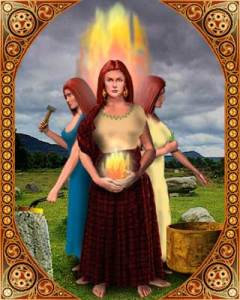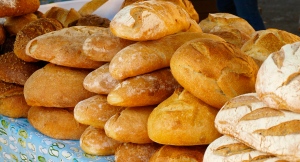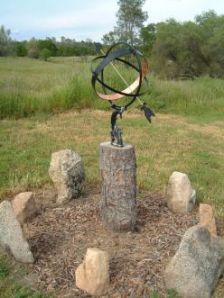Lammas is the first of the harvest festivals, and if you live in the Northern Hemisphere, it begins August 1. This is one of modern Paganism’s Sabbats that has its roots in agricultural societies, and a time to celebrate the upcoming fall harvest. It’s the time of year when the first grains are threshed, bread is baked, and people begin storing up for the coming winter months. In some traditions, it’s also a season to honor Lugh, the craftsman god. Meanwhile, if you’re one of our Southern Hemisphere readers, you’re probably preparing for Imbolc, which honors the returning sun as spring looms around the corner. In many traditions, it’s a time to honor the goddess Brighid as well. Whichever one you’re ce
 lebrating, may you and your family have a joyful and blessed Sabbat!
lebrating, may you and your family have a joyful and blessed Sabbat!What is Lammas (Lughnasadh)? – How to Celebrate Lammas
It’s the dog days of summer, the gardens are full of goodies, the fields are full of grain, and the harvest is approaching. Take a moment to relax in the heat, and reflect on the upcoming abundance of the fall months. At Lammas, sometimes called Lughnasadh, it’s time to begin reaping what we have sown throughout the past few months, and recognize that the bright summer days will soon come to an end.
The Beginning of the Harvest
At Lammas, also called Lughnasadh, the hot days of August are upon us, much of the earth is dry and parched, but we still know that the bright reds and yellows of the harvest season are just around the corner. Apples are beginning to ripen in the trees, our summer vegetables have been picked, corn is tall and green, waiting for us to come gather the bounty of the crop fields. Now is the time to begin reaping what we have sown, and gathering up the first harvests of grain, wheat, oats, and more. This holiday can be celebrated either as a way to honor the god Lugh, or as a celebration of the harvest.
Celebrating Grain in Ancient Cultures
Grain has held a place of importance in civilization back nearly to the beginning of time. Grain became associated with the cycle of death and rebirth. The Sumerian god Tammuz was slain and his lover Ishtar grieved so heartily that nature stopped producing. Ishtar mourned Tammuz, and
 followed him to the Underworld to bring him back, similar to the story of Demeter and Persephone.
followed him to the Underworld to bring him back, similar to the story of Demeter and Persephone.
In Greek legend, the grain god was Adonis. Two goddesses, Aphrodite and Persephone, battled for his love. To end the fighting, Zeus ordered Adonis to spend six months with Persephone in the Underworld, and the rest with Aphrodite.
A Feast of Bread
In early Ireland, it was a bad idea to harvest your grain any time before Lammas — it meant that the previous year’s harvest had run out early, and that was a serious failing in agricultural communities. However, on August 1, the first sheafs of grain were cut by the farmer, and by nightfall his wife had made the first loaves of bread of the season. The word Lammas derives from the Old English phrase hlaf-maesse, which translates to loaf mass. In early Christian times, the first loaves of the season were blessed by the Church.
Honoring Lugh, the Skillful God
In some Wiccan and modern Pagan traditions, Lammas is also a day of honoring
 Lugh, the Celtic craftsman god. He is a god of many skills, and was honored in various aspects by societies both in the British Isles and in Europe.Lughnasadh (pronounced Loo-NAS-ah) is still celebrated in many parts of the world today. Lugh’s influence appears in the names of several European towns.
Lugh, the Celtic craftsman god. He is a god of many skills, and was honored in various aspects by societies both in the British Isles and in Europe.Lughnasadh (pronounced Loo-NAS-ah) is still celebrated in many parts of the world today. Lugh’s influence appears in the names of several European towns.Celebrating Lammas Today & Honoring the Past
In our modern world, it’s often easy to forget the trials and tribulations our ancestors had to endure. For us, if we need a loaf of bread, we simply drive over to the local grocery store and buy a few bags of prepackaged bread. If we run out, it’s no big deal, we just go and get more. When our ancestors lived, hundreds and thousands of years ago, the harvesting and processing of grain was crucial. If crops were left in the fields too long, or the bread not baked in time, families could starve. Taking care of one’s crops meant the difference between life and death.
By celebrating Lammas as a harvest holiday, we honor our ancestors and the hard work they must have had to do in order to survive. This is a good time to give thanks for the abundance we have in our lives, and to be grateful for the food on our tables. Lammas is a time of transformation, of rebirth and new beginnings.
Symbols of the Season
The Wheel of the Year has turned once more, and you may feel like decorating your house accordingly. While you probably can’t find too many items marked as “Lammas decor” in your local discount store, there are a number of items you can use as decoration for this harvest holiday.
The Wheel of the Year has turned once more, and you may feel like decorating your house accordingly. While you probably can’t find too many items marked as “Lammas decor” in your local discount store, there are a number of items you can use as decoration for this harvest holiday.
No comments:
Post a Comment